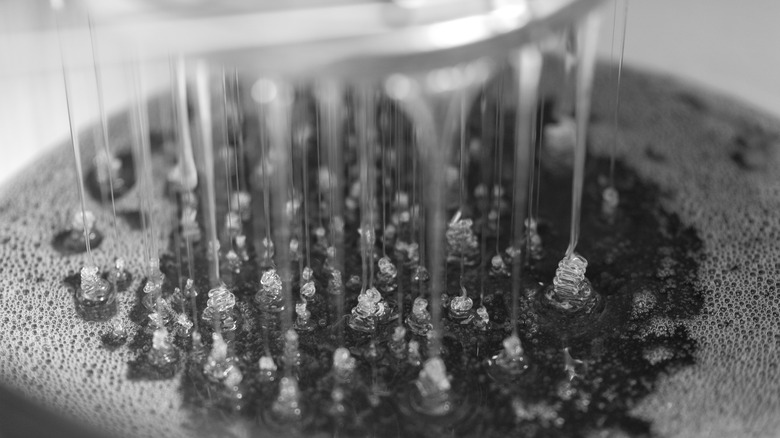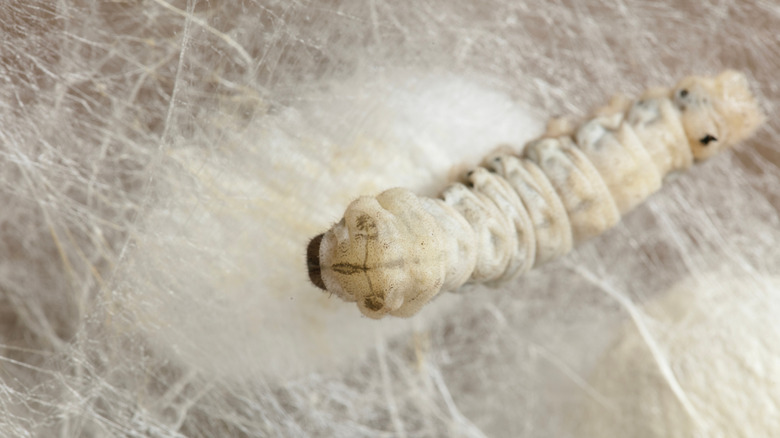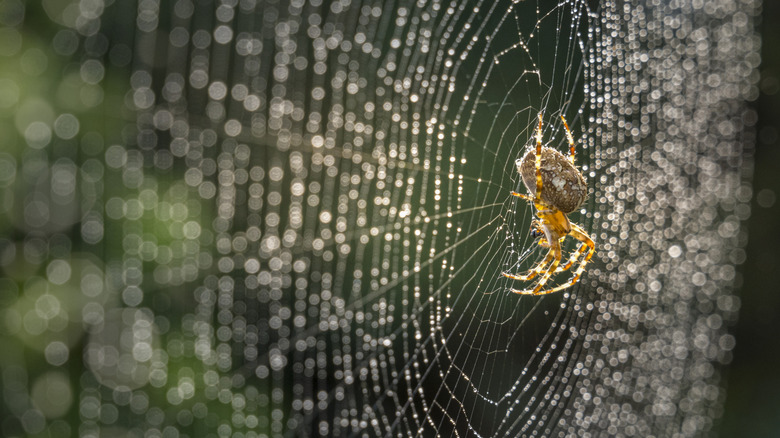Scientists Accidentally Created A Sticky Substance Straight Out Of A Sci-Fi Movie
When you think of silk, a silkworm might come to mind. One of the most well-known facts about silkworms is that they spin their own silk. However, they aren't the only creatures that do. The cocoon a caterpillar builds is made of silk, and even during an inchworm's life cycle, it uses silk threads to lower itself to the ground. And, the sticky, silk fibers used to accidentally create a new substance similar to Spider-Man's webbing was derived from silk moth cocoons.
Researchers at the Tufts University Silklab work with silks that naturally occur in nature, reimagining them into biomaterials for advanced technologies. For instance, it has pioneered edible coatings to make produce last longer and glues that are so powerful they hold up underwater — both by using Regenerated Silk Fibroin (RSF), which is a building block protein derived from boiling silk moth cocoon fibers in a solution. After struggling to make progress mastering the adhesive, elastic, and stiff properties of spider web threads, Tufts University research assistant professor Marco Lo Presti made a breakthrough by accident.
He explained in a statement, "I was working on a project making extremely strong adhesives using silk fibroin, and while I was cleaning my glassware with acetone, I noticed a web-like material forming on the bottom of the glass." With further testing, the scientists created a silk fibroin solution that solidifies almost immediately and is strong enough to lift small objects — kind of like Spider-Man's webbing. The findings were published in Advanced Functional Materials in September 2024.
How the strong, web-like material is made
As a Spider-Man fan, Marco Lo Presti was excited by his accidental find in 2018. With the help of other researchers at Silklab, he spent 18 months collecting data and testing various combinations of RSF with solvents to create web-slinging technology and replicate spider threads. RSF solutions that are exposed to organic solvents, such as acetone or ethanol, form semi-solid hydrogels, but it takes hours for the transformation to fully develop. When dopamine, which can be used to make some of the strongest types of glue, was added to the solution, the solidification process was almost instant because the water in the solution was pulled away from the fibroin, creating fibers that strongly adhered to surfaces — just like barnacles.
After figuring out how to make the solution sticky and solidify faster, Lo Presti and his team plunged it through a coaxial needle. The result was a thin stream surrounded by an acetone layer, which evaporated and triggered the solidification. What was left was a fiber attached to whatever object it touched. Next, the researchers added chitosan — an insect exoskeleton derivative — to give the fibers up to 200 times more tensile strength, as well as a borate buffer for an 18-fold increase in stickiness. With these modifications, the plunged fibers were able to pick up objects weighing up to 80 times more than their own weight, such as a partially sand-buried scalpel, a steel bolt, and a block of wood.
Lo Presti told Tufts Now, "[Spiders] usually spin the silk out of their gland, physically contact a surface, and draw out the lines to construct their webs. We are demonstrating a way to shoot a fiber from a device, then adhere to and pick up an object from a distance. Rather than presenting this work as a bio-inspired material, it's really a superhero-inspired material."
Real-life Spider-Man, web-slinging wrist shooters aren't impossible
The stuff of Marvel comic book lovers' dreams sounds too good to be true. However, in an episode of "The Official Marvel Podcast," Tufts University biomedical engineering professor Fiorenzo Omenetto didn't discount the possibility of developing a real-life homage to Spider-Man in the form of webbing that could be shot from a compact wrist device — unlike how a spider spins its web — with some more research in the design.
When talking about the lab, Omenetto said that the driving force behind their innovation is that the researchers believe that materials from nature can do unexpected things. While it's hard to speculate the heaviest object a material like this could hold, he explained, "Silk itself has a very impressive combination of tensile strength and elasticity. It's one of its superpowers, and that allows it to absorb a lot of energy and to support very heavy loads. And so, when we engineer our materials, some of these properties come along naturally because our building blocks are the same building blocks that you would have in natural silk. So, we could think about having a lot of weight supported without it breaking."
Omenetto also noted that, in other research, they've been able to create a little, light spider web that held 4,000 times its weight. He added that the lab uses silk because spiders aren't as friendly as caterpillars.


